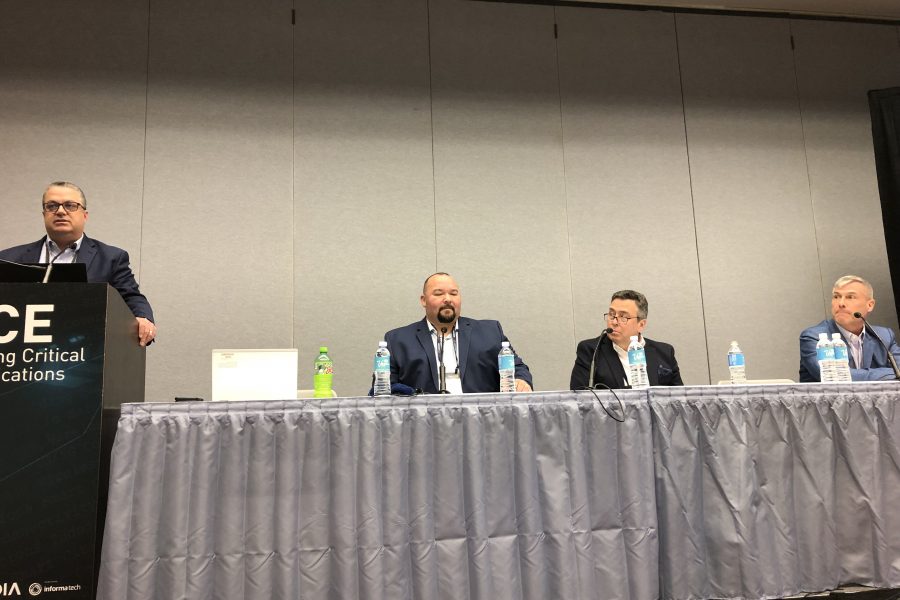PTT over FirstNet gains traction, with some entities planning to abandon LMRPTT over FirstNet gains traction, with some entities planning to abandon LMR

LAS VEGAS—Perceived primarily as a data-centric network, FirstNet connectivity is gaining traction as a mission-critical-voice alternative to traditional land-mobile-radio (LMR) technology, as speakers during IWCE 2022 conference sessions have noted this week.
Push-to-talk (PTT) solution ESChat was one of the first applications included in the FirstNet App Catalog when it was established years ago, but all forms of PTT over FirstNet primarily have been used as augmentations to LMR systems, which has been a foundation of public-safety communication for more than 60 years. But that situation is changing, with multiple entities this week unveiling plans to use PTT over FirstNet for their primary mission-critical voice communications while shuttering aging LMR networks that would have required costly upgrades.
“This is the future of communications,” Dallas (Ga.) Police Chief Joe Duvall said Wednesday during a session highlighting FirstNet use cases (panel pictured above; Duvall is the third from the left).
For Dallas, Ga., the existing LMR network was reaching end of life, and the city was told that an upgrade would cost more than $2 million, not including the resources to manage the buildout project and the ongoing maintenance costs associated with owning a private LMR system, Duvall said.
By opting for PTT over FirstNet, the city will get better coverage than it would with LMR at a cost of less than $200,000, with minimal project headaches and no network-maintenance obligations, Duvall said.
Dallas, Ga., has used Sonim XP8 as its PTT device operating on the FirstNet system that provides priority and preemption to public-safety subscribers, Duvall said. The Sonim devices cost 99 cents, while radios for the city’s old LMR system cost between $800 and $1,000 each, he said.
Duvall said the police department is in the process of testing the Siyata S7 that leverages Wi-Fi and supports dual-carrier connectivity. The Siyata device only supports push-to-talk communications, so carrier connectivity can be provided through IoT rate plans that are fraction of the cost of a monthly rate plan for a smart device with access to the Internet.
This new push-to-talk service over FirstNet system that his department converted to far outweighs “the cost of a long-term [LMR] deal that isn’t going to be a part of future communications,” Duvall said during a Tuesday session at IWCE. After experiencing this new era of emergency communication ushered in by FirstNet, Duvall said that he’s convinced “it’s never going to go backward.”
“We’ve come a long way with it in a short amount of time,” Duvall said on Tuesday “The future is here, and I’m glad we’re a part of it.”
At least in part, Duvall says this is because, as he sees it, all of the large movers in the telecommunication business are “getting in with this basically from the ground floor to help push the technology forward.” From a user’s standpoint, it’s been an easy integration for his organization so far. There aren’t any towers to maintain, and if a device fails, it can be replaced with minimal hassle. Further, so far, “the coverage has been better than prior what we had,” he continued. “We have no dead spots, like we had with the old (radio) system.”
A similar scenario has occurred in Pennsylvania, where the Pennsylvania Turnpike Commission is migrating all of its PTT voice communications to an MCPTT offering operating on the FirstNet.
Like Dallas, Ga., the turnpike commission needed to replace its aging analog LMR network, which had significant coverage issues, particularly when personnel were near sound-wall barriers on the side of the road. The first alternative pursued was to upgrade to a 700 MHz P25 system, but multiple consultants said that it would require doubling the 26 tower sites used in the existing analog LMR network, according to Mike Metz, senior network engineer for the Pennsylvania Turnpike Commission.
“And most of those [new sites] would be greenfield,” Metz said, underlining the potential project challenges and expense of such an effort.
The Pennsylvania Turnpike Commission had been using EPTT from AT&T for years and conducted an internal review of the coverage it would get from FirstNet, built by AT&T.
Rob Nekich, network analyst for the Pennsylvania Turnpike Commission, said he was “surprised” when the tests—conducted with the Pinpoint application from Televate—demonstrated a 99.48% success rate for PTT calls using handheld devices, including when personnel were located near the sound-wall barriers on the turnpike. In addition, 92 of the 96 facilities tested proved to have good in-building coverage.
Nekich described the availability of L3Harris XL series portable radios with LTE connectivity as a “game-changer” for the project, as these devices are expected to ease the transition from LMR to LTE while allowing certain users to remain comfortable with a radio form factor.
Nekich acknowledged that the turnpike commission’s situation may not be applicable to all other entities, as its communications needs are concentrated on a busy roadway—the type of environment where carriers want to provide coverage. However, as FirstNet continues to expand its coverage footprint, Nekich said he would advise other entities to at least consider broadband PTT alternatives before committing to a long-term upgrade to an LMR system that provides only voice service.
“I think we’re in a unique position with the roadway coverage that we’re getting from FirstNet,” Nekich said during an IWCE session on Tuesday. “Depending on their geographical needs for radio communications, I would say that they should investigate it.
“Will it be for everybody? No. But I wouldn’t not investigate it. I think it’s important to see where FirstNet is and where the coverage is, to [determine if it is] a viable solution.”





